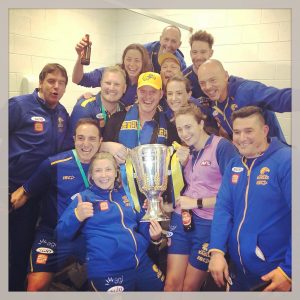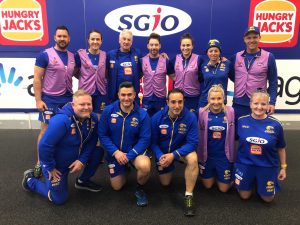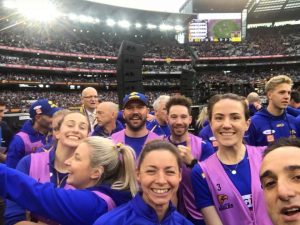 Jeepers! What a month September was! A combo of intense training, a successful Prelim Final with West Coast and then a trip to Melbourne as part of the GF travel team (and we all know how that finished!) Plus all the end of season events after, including the John Worsfold Medal (Best & Fairest Awards). All very exciting but at the same time, many a text message to my coach to rearrange trainings, manage travel and the additional workload that a GF brings. Not that I am complaining. Not one little bit. It was amazing! Every. Single. Minute. Finally, three weeks later, I’m at the other end and able to provide an update on my Ironman adventures.
Jeepers! What a month September was! A combo of intense training, a successful Prelim Final with West Coast and then a trip to Melbourne as part of the GF travel team (and we all know how that finished!) Plus all the end of season events after, including the John Worsfold Medal (Best & Fairest Awards). All very exciting but at the same time, many a text message to my coach to rearrange trainings, manage travel and the additional workload that a GF brings. Not that I am complaining. Not one little bit. It was amazing! Every. Single. Minute. Finally, three weeks later, I’m at the other end and able to provide an update on my Ironman adventures.
Weeks 9 to 11 of training
My training load has been pretty stable at 18 hours per week, plus some extra stretching and strength exercises for injury prevention. Swims are averaging 9-10km/wk, Rides 200km/wk and runs 54km/wk. I also decided during this training block edit my fundraising goal for Beyond Blue and aim to raise a $ for every km I’ve trained.
Bank a $ for a K.
As of today (with less than six weeks to go) my total is 126km of swimming, 2127km of riding and 587km of running. A fundraising goal of $3039.50. To contribute hit up my fundraising page
Fuelling Long Runs
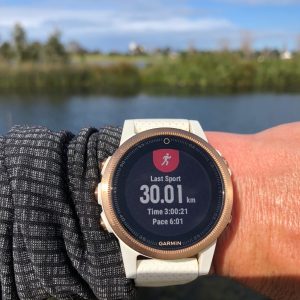 This training block my main focus was fuelling my long runs. Sitting around 28 to 30km meant I would normally be out for 2.5 to 3 hours and also seemed to line up with game day for footy. This required some extra forward planning to ensure I had adequate recovery nutrition before working the game.
This training block my main focus was fuelling my long runs. Sitting around 28 to 30km meant I would normally be out for 2.5 to 3 hours and also seemed to line up with game day for footy. This required some extra forward planning to ensure I had adequate recovery nutrition before working the game.
Hydration
Running for three hours means planning carbohydrate and fluid intake first up. It’s very easy to forget about drinking, especially in winter and carrying a bottle can get annoying. There are a few options to help keep you hydrated;
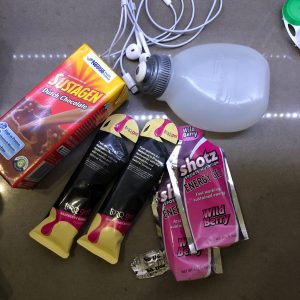 Run where there are regular drink fountains – along the coast in Perth is great as there are many between Swanbourne and North Beach – one of my favourite run routes.
Run where there are regular drink fountains – along the coast in Perth is great as there are many between Swanbourne and North Beach – one of my favourite run routes.- Run with a fuel belt and carry 1-4 fuel belt bottles.
- Run with a normal bottle – 500-750ml.
I run with a fuel belt bottle (about 200mL) in my tri top pocket and refill at water fountains along the way.
I aim to drink every 2km, just like on race day, where aid stations are 2km apart,
and increase the volume drunk depending on the temperature for the day.
Fuel
Any runs over 60 to 90 minutes will most likely benefit from a top up of carbs during the run. Gels are the most easiest;
I aim for one gel every 7km
but for some faster runners I would suggest every 10km. Lollies, snakes or sports chews (like Clif shot bloks) are all good alternatives but you need to eat them more often or in larger quantities to equate to a gel. eg: 3 “Bloks” = 1 gel.
Race day I put all my gels into a flask, although for race day it will be a fuel belt bottle as I need 5 gels for 42km and only 3 fit in a flask. The flask means less sticky fingers and no wrappers to worry about.
Endurance Nutrition
Caffeine. Once carbohydrate and fluid intake are on track, caffeine would be the next thing to consider. Caffeine is an ergogenic aid that reduces the perception of exercise intensity and increases alertness. A win all round for endurance athletes. However there are some side effects, such as increased heart rate and body temperature, so it’s important to trial in training and/or discuss with your GP if you have any issues.
Caffeine dosage is normally ~3mg/kg and I use products that provide 80-100mg per serve. Gels, No Doz and caffeine gum.
On a long run I’ll have one dose at the half way mark.
Now onto the final big training block where I’ll finalise my carb loading, pre race, ride and run nutrition with some solid hit outs planned!




